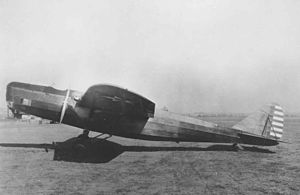| XB-8 | |
|---|---|
 | |
| Atlantic XB-8 prototype | |
| Role | Bomber |
| Manufacturer | General Aviation Corporation.[1] |
| Designer | Fokker |
| Primary user | United States Army Air Corps |
| Number built | 7 (1 XB-8 + 2 YB-8 + 4 Y1B-8), all as Y1O-27 |
The Fokker XB-8 was a bomber built for the United States Army Air Corps in the 1920s, derived from the high-speed Fokker O-27 observation aircraft.
Design and development
During assembly, the second prototype XO-27 was converted to a bomber prototype, dubbed the XB-8. While the XB-8 was much faster than existing biplane bombers, it did not have the bomb capacity to be considered for production. Two YB-8s and 4 Y1B-8s were ordered, but these were changed mid-production to Y1O-27 configuration.
The wing of the XB-8 and XO-27 was built entirely from wood, although the fuselage was constructed of steel tubes covered with fabric with the exception of the nose which had a corrugated metal.[1] They featured the first retractable landing gear ever fitted to an Army Air Corps bomber or observation craft. The undercarriage retracted electrically. Crew was three in tandem position.[1]
Operational history
It competed against a design submitted by Douglas Aircraft Company, the Y1B-7/XO-36. Both promised to greatly exceed the performance of the large biplane bombers then used by the Army Air Corps. However, the Douglas XB-7 was markedly better in performance than the XB-8, and no further versions of Fokker's aircraft were built.
Operators
Specifications (XB-8)
Data from Fokker's Twilight.[2]
General characteristics
- Crew: 4
- Length: 47 ft 4 in (14.42 m)
- Wingspan: 64 ft 4 in (19.60 m)
- Height: 11 ft 6 in (3.50 m)
- Wing area: 619 sq ft (57.5 m2)
- Empty weight: 6,861 lb (3,112 kg)
- Gross weight: 10,650 lb (4,824 kg)
- Powerplant: 2 × Curtiss V-1570-23 "Conqueror" V12 engines, 600 hp (450 kW) each
Performance
- Maximum speed: 160 mph (260 km/h, 140 kn)
See also
Aircraft of comparable role, configuration, and era
Related lists
References
Notes
- ^ a b c Cellier, Alfred (23 August 1934), "American Military Monoplanes", Flight, p. 864
- ^ Pelletier 2005, p. 64.
Bibliography
- Pelletier, Alain J. "Fokker Twilight". Air Enthusiast, No. 117, May/June 2005, pp. 62–66. ISSN 0143-5450.
- Wagner, Ray. American Combat Planes. New York: Doubleday, 1982. ISBN 0-930083-17-2.
External links
- O-27 USAAS 1000 Aircraft Photos
- Army's Mystery Plane Passes Speed Test – Popular Science
- Atlantic (Fokker) XB-8 – National Museum of the US Air Force